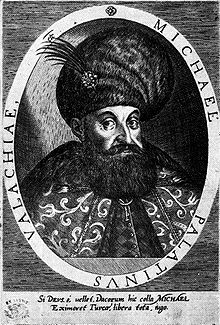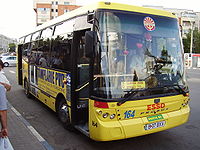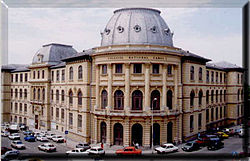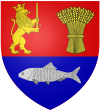- Craiova
-
Coordinates: 44°20′00″N 23°49′00″E / 44.333333°N 23.816667°E
Craiova Dolj County Prefecture 
Coat of armsNickname(s): Bans' Citadel
(Romanian: Cetatea Băniei)Location of Craiova Coordinates: 44°20′N 23°49′E / 44.333°N 23.817°E Country  Romania
RomaniaCounty Dolj County Status County capital Government – Mayor Antonie Solomon (UNPR) Area – City 81.4 km2 (31.4 sq mi) – Metro 550.1 km2 (212.4 sq mi) Population (est. 2010[1]) – City 298,740 – Density 3,668/km2 (9,500.1/sq mi) – Metro 333,834 Time zone EET (UTC+2) – Summer (DST) EEST (UTC+3) Website http://www.primariacraiova.ro/ Craiova (Romanian pronunciation: [kraˈjova]), Romania's 6th largest city[1] and capital of Dolj County, is situated near the east bank of the river Jiu in central Oltenia. It is a longstanding political center, and is located at approximately equal distances from the Southern Carpathians (north) and the River Danube (south). Craiova is the chief commercial city west of Bucharest and the most important city of Oltenia. The city prospered as a regional trading centre despite an earthquake in 1790, a plague in 1795, and a Turkish assault in 1802 during which it was burned.
Eight villages are administered by the city: Făcăi, Mofleni, Popoveni, Şimnicu de Jos, Cernele, Cernelele de Sus, Izvoru Rece and Rovine. The last four were a separate commune called Cernele until 1996, when they were merged into the city.
Contents
History
Craiova, which occupied the site of the Dacian and Roman city Pelendava, was formerly the capital of Oltenia. One of the most important geto - dacian settlement of the Craiova aeria (Mofleni zone) was Pelendava, dating since the period 400 - 350 BC as the archaeological findings indicate. At the beginning of the second century AD, the Romans have built here a Roman camp, made from hard soil, afterwards made from rock and bricks (during the time of Hadrian, 117 - 138). Due to the favourabile geographical position, the protection of the Roman camp and the military garrison, the Roman Pelendava has known a thriving life. The settlement is mentioned in the Tabula Peutingeriana - a map of the Roman Empire, made at the request of the Roman emperor Caracalla. The year 225 (when this map was finished during Severus Alexander) is considered the first documentation mentioned of the oldest settlement from the nowadays city area.
Its ancient bans, the highest ranking boyars of the Wallachian state, initially those of the Craioveşti family. The bans had the right of minting coins stamped with their own effigies – the origin of the Romanian word ban as used for coins.
The economical power of the Craiovesti family at the end of the XVI century was about 100 villages (182 financial goods). This power gave them a statute of political autonomy so big, that the hospodars ruling at that time weren't able to keep in power without an alliance with this powerful dynasty. From the Craiovesti family there were chosen a lot of hospodars to rule the country: Neagoe Basarab, Radu de la Afumaţi, Radu Serban (1602–1611), Matei Basarab, Constantin Şerban, Şerban Cantacuzino, Constantin Brâncoveanu.
In 1395 Craiova was probably the scene of a victory won by the Wallachian Prince Mircea I of Wallachia over Bayezid I, Sultan of the Ottomans (see Battle of Rovine).
Frequently referred to as "a city" after the first half of the 16th century, the Craiova area was always regarded as an important economic region of Wallachia and Romania at large. During the 1718–1739 Habsburg occupation of Oltenia, Craiova's status declined due to economic pressures and increased centralism, partly leading to an increase in hajduk actions, in parallel with protests of Craiovan boyars. In 1761, under Prince Constantine Mavrocordatos, the bans relocated to Bucharest, leaving behind kaymakams to represent them in Craiova.
Under Prince Emanuel Giani Ruset, Wallachia's seat was moved to Craiova (1770–1771), viewed as a place of refuge during the Russo-Turkish War of 1768–1774. A large part of the city was burned down by the rebel pasha Osman Pazvantoğlu in 1800.
During the Wallachian uprising of 1821, inhabitants of the present-day Dolj County joined Tudor Vladimirescu's Pandurs in great numbers, contributing to the expedition on Bucharest. During the first two decades of the 19th century, Craiova witnessed economic prosperity, centered on handicraft trades and public services. During Imperial Russian occupation and the early stages of Organic Statute rules (1828–1834), the city increased its economic output; in 1832 there were 595 shops, 197 made of which were barracks and 398 were houses built of brick. At the time, Craiova exported wheat, furs, leather, live animals and other products into the Austrian and Ottoman Empires.
Costache Romanescu, a citizen of Craiova, was among the leaders of the Provisional Government during the 1848 Wallachian revolution. Wallachia's last two rulers, Gheorghe Bibescu and Barbu Dimitrie Ştirbei, came from an important boyar family residing in Craiova – the Bibescu family.
Around 1860, there were 4,633 buildings in Craiova, which were 3,220 houses, 26 churches, 11 schools and 60 factories and workshops. In all, the city also housed about 90 industrial establishments, of which 12 were mills, 3 breweries, 2 gas and oil factories, 4 tanning yards and 2 printing presses; 57% of the total number of craftsmen of Dolj County lived in Craiova (1,088 craftsmen, 687 journeymen and 485 apprentices).
The period following the Independence War was a time of economic and cultural progress. As a result, at the end of the 19th century, the city of Craiova, with its 40,000 inhabitants, had developed small factories (producing chemicals, farming utilities, and construction materials) and textile factories. On October 26, 1896, the Craiova power station entered service (with AEG equipments working at 310 CP, supplying 365 streetlights on 39 streets, forming a 30 km-long network); Craiova was the first city in the country to be supplied with electric power by internal combustion engines.
In 1900, Craiova had 43.1% of the industrial units of Oltenia; these numbered 924 industrial companies (including 20 large industrial establishments, employing 1,078 workers). The number of large industrial establishments rose to 40 by 1925. Banking also developed at the beginning of the 20th century (when 6 banks and 2 bureaux de change were already operating).
In the interwar period, Craiova, as the centre of an agricultural region, experienced little further industrialization; the number of industrial workers remained comparatively small. In 1939, Craiova had 7 industrial units with over 100 workers: the clothing industry companies Oltenia and Scrisul Românesc were well-known all over the country and abroad.
In the early 1960s, under the Communist regime, the city become a noted centre for the automotive and engine building industries, as well as for aerospace manufacturing, chemical industry, food industry, construction, electrical engineering, mining and the electrical power industry.
After the 1989 Revolution brought the re-establishment of a free market and decentralisation in overall management, several industries became subject to privatisation, while the market opened itself to private initiatives. Industry, although affected by economic changes, remains an important branch, representing ca. 70% of Craiova's output
Demographics
Historical population of Craiova Year Population %± 1900 45,438[2] — 1912 census 51,404[3] 13.1% 1930 census 63,215 22.9% 1948 census 84,574 33.7% 1956 census 96,897 14.5% 1966 census 148,711 53.4% 1977 census 221,261 48.7% 1992 census 303,959 37.3% 2002 census 302,601 −0.4% 2007 estimate 299,429[4] −1% According to the last Romanian census, from 2002, there were 302,601 people living within the city of Craiova, making it the sixth most populous city in Romania. Ethnic composition:
- Romanians: 292,487 (96.66%)
- Hungarians: 218 (0.07%)
- Germans: 173 (0.06%)
- Serbs: 34 (0.01%)
- Roma: 8,820 (2.91%)
- Italians: 178 (0.06%)
- Greeks: 188 (0.06%)
- Ukrainians: 32 (0.01%)
and 471 others.
As of 2010, an estimated 298,740 inhabitants live within the city limits.[1]
Economy
In the first two decades of the 19th century Craiova is characterized by economical growth, multiplication of its habitants` preoccupations in the areas of trade, commerce, and public services. In comparison with other great urban centers, Craiova is situated as a commercial, administrative and cultural knot of prime order.
During the Tsarist take-over (1828–1834), Craiova goes trough important economical growths. In 1832, there were a number of 595 shops, of which "187 of wood and 398 of stone wall". The city is maintained as the commercial centre of Oltenia; it was exporting to Austria and Turkey cereal, skins, wax, animals, tallow and cervices. As a follow-up of the permanent high demands of export, at Craiova was established, in 1846, the first Romanian society on share holds for cereal transport by ship on the Danube, to Brăila.
Around 1860 in Craiova there were 4633 buildings, of which 3220 were houses, 26 churches, 11 schools, 60 factories - workshops. There were also approximately 90 establishments with an industrial character, of which: 12 wind mills, 3 beer factories, 2 gas and oil factories, 4 tanneries, 2 printings. Statistics show that there was, at Craiova, a percent of 57,7% of the total number of craftsmen from the Dolj County (1088 craftsmen, 687 journeymen and 485 apprentices). Towards the ending of the XIX century, Craiova was a city that had small factories and workshops with chemical products, agricultural machines, graphics art, tanneries, textiles, construction materials, etc. At 26 October 1896 Craiova's power plant starts working (with AEG equipment - Allgemeine Elekticitats Gesellschaft), having an installed power of 310 power horse, and supplying 365 lamps on 39 streets in a network of 30 km (18.64 mi). Craiova was the first city of the country powered up with electricity based on engines with internal combustion.
In 1900, Craiova was holding 43, 1% of the number of the industrial units of Oltenia, having 924 industrial firms (of which 20 establishments were belonging to the big industry, using 1078 workers). In 1925, the number of establishments of the "big industry" was up to 49, and in 1930 the number of workers was of 5530. The bank commerce was affirming as well, at the beginning of the 20th century already existing 6 banks and 2 exchange offices.
In the Interbelic period, the city, situated in an area eminently agricultural, was moving forward with too small steps toward the industrial way, in comparison with other urban areas of the country. The number of those who got close to industry was extremely small.
In 1939, in Craiova were only 7 industrial units with over 100 workers: The cloth factory "Oltenia", "Scrisul Romanesc"("The Romanian Writing"), the macaroni factory "Concordia", the bread and macaroni factory "Barbu Druga", "Semanatoarea", The electrical factory and the bread factory "Traiul". The only industrial branch that had industrial units comparable with similar units of other centers of the country was the industry of graphic art. The two printings "Ramuri" and "Scrisul romanesc" were well known all over the country and abroad.
Starting with the 1960s the city becomes a powerful industrial center; it develops the industry of machine and tools construction, planes, the chemical industry, food industry, easy industry, of construction materials, electro technical, extractive, energetic industry. The Romanian Revolution of 1989 led to important changes in economy, by realizing a free market and by decentralizing the management of all national economic sectors. A value for the property sense was reinstated by liberating the particular initiative and privatization of goods that belonged exclusively to the state. In industry a drop of all capacity production was noticed, determined by the fact that they couldn't anticipate the direction of the impact of change and size of the shocks that followed the modification of the economical-social system. Still, the industry continues to represent the branch of activity with great influence over the city's economy (70%).
During the post-Revolution period, telecommunication services, banking and insurance, management consulting (CDIMM, Romanian-American Center) began expanding. The number of joint ventures and the value of invested capital at county level have increased to large numbers — Dolj County being the first in respect to these aspects.[citation needed] The Automobile Craiova factory, formerly owned by Daewoo and renationalised after Daewoo's bankruptcy, was sold in September 2007 to Ford.
Ford will produce in Romania the B-Max model, a small class mono volume. The aspect of the new model will be somewhere between Ford Fiesta and C-Max, but smaller than the latter. The American manufacturer expects to become the second biggest seller in Romania after Dacia. In 2009, Craiova works delivered 300 Ford Transit Connect units to the market.
Of the city's working population (about 110,000 persons), 38% are employed in industry, 15% in trade and repair services, 10% in transport and storage, 8% in education, 5.7% in the medical field.[citation needed]
Transport
Public transportation in Craiova started in September 1948 with only 2 busses, received from Bucharest. The busses connected the Craiova railway station with the Nicolae Romanescu Park.
The Tram was first introduced in 1987, on a 18,4 km (2.49 mi) double-track line, as a result of the state's intention of keeping energy consumption low. The public transport in Craiova today consists of 3 trolley tram lines and 17 bus lines. It is operated by the Regia Autonomă de Transport Craiova (RAT Craiova), a corporation run by City Hall. One ticket is around €0.5. There are 342 busses and 49 trams serving the city today.
Craiova is also a major railway centre and is connected to all other major Romanian cities, as well as local destinations, through the national Căile Ferate Române network. Check the national railway timetable for an appropriate connection.
There are daily trains with service from Craiova to: Bucharest (3 hours), Braşov (6 – 8 hours - via connecting service), Cluj-Napoca (8 – 10 hours - connecting service), Sibiu (4 – 7 hours), Sighişoara (8 – 11 hours - connecting service), Timişoara ( 5 hours)
The city's taxicabs are very cheap. Usually you do not pay more than €1-€2 (around €0.3/km).
The city is served by Craiova Airport.
Landmarks
- Madona Dudu Church – built between 1750 and 1756, renovated in 1844, after being destroyed by an 1831 earthquake. Murals were completed by Gheorghe Tattarescu.
- St. Demetrius Church
- The Church of Coşuna Monastery – the oldest building preserved in Craiova, dating from 1483.
- Băniei House – the oldest non-religious building that exists in Craiova, dating from 1699. Today it hosts the Museum of Ethnography and Folk Art.
- Craiova Art Museum – the building that houses the museum was built in 1896, following the plans of the French architect Paul Gotereau. Its main attraction is the art gallery dedicated to Constantin Brâncuşi, exhibiting six of his early sculptures (including variants of his best-known works): The Kiss (1907), Vitellius (1898), Woman Torso (1909), The Vainglory (1905), Boy's Head (1906), Miss Pogany (1902).It also has a variety of paintings by leading Romanian masters such as;Theodor Aman, Nicolae Grigorescu, Vasile Popescu, Stefan Luchian, and Theodor Pallady plus some Romanian icons.
- Museum of Oltenia – founded in 1915 and divided into three sections: ethnography, history and natural science. The collection is based on donations made in 1908.
- Nicolae Romanescu Park (formerly Bibescu Park) – the largest and most well-known park in Craiova. Through the initiative of Nicolae P. Romanescu, the mayor of Craiova at that time, the park was designed by French architect Émile Rendont. Plans for the park were awarded the gold medal at the 1900 World Fair; work began in 1901 and was completed in 1903.
- Botanical Garden – The garden was laid out by the botanist Alexandru Buia and was opened in 1952. The main purpose of the garden was to facilitate the students' activities and research for the academic staff of the Agriculture and Horticulture Faculties of the University of Craiova. The Botanical Garden is organized in six areas: plant systematics, floral provinces of the globe, cultivated plants, seed beds, phyto-geography of the Oltenia region, and a greenhouse.
- Jiu Meadow
Education
The first school in Craiova was founded in 1759 by Constantin Obedeanu. In the spring of 1826 Obedeanu's school took the name Şcoala Naţională de Limba Română which means National School of Romanian Language. This was the second Romanian high school after Saint Sava high school in Bucharest (founded in 1818).
Primary schools
- Obedeanu School
- Traian School
- Decebal School
High schools
- Henri Coanda High School
- Carol I High School (former Nicolae Bălcescu High School).
- Fratii Buzesti High School
- Elena Cuza National College
- Stefan Odobleja Computer Science High School
- Traian Vuia High School
- Nicolae Titulescu High School
- Stefan Velovan High School
- "Constantin Brâncuşi" Technical College of Arts and Handicrafts
Universities:
Sport
The first football teams in Craiova appeared in 1921, Craiovan Craiova and Rovine Griviţa Craiova. They merged in 1940, forming FC Universitatea Craiova. They became the first Romanian football team to reach the semi-finals of a European tournament, during the UEFA Cup in 1982-83.
- FC Universitatea Craiova – football team relegated to Liga II at the end of the 2010-2011 season[5]
- Gaz Metan CFR Craiova FC - Liga II football team
Shopping
- Real Craiova
- Selgros
- Metro Cash&Carry
- Kaufland x2
- Mercur
- Billa
- Praktiker
- Dedeman
- Baumax
- Lidl (soon)
Natives
- Constantin Argetoianu, former Prime Minister
- Corneliu Baba, painter
- Gheorghe Bibescu, Prince of Wallachia
- Lola Bobesco, violinist
- Adrian Cioroianu, historian, politician
- Constantin Coandă, former Prime Minister
- George Constantinescu, scientist, engineer and inventor
- Diana Dondoe, international supermodel
- Dimitrie Gerota, anatomist and physician
- Titu Maiorescu, former Foreign Minister and Prime Minister
- Jean Negulesco, film director and screenwriter
- Petrache Poenaru, inventor of the world's first fountain pen
- Eduard Prugovečki, physicist, mathematician
- Constantin Sănătescu, former Prime Minister
- Francisc Şirato, painter
- Barbu Ştirbei, prince of Wallachia
- Nicolae Titulescu, Foreign Minister and president of the League of Nations
- Ion Ţuculescu, painter
- Nicolae Vasilescu-Karpen, engineer, pioneer in telegraphy and telephony
- Varujan Vosganian, politician
- Sorin Lerescu, renowned composer
- Argentina Menis, athlete
Politics
The Craiova Municipal Council, chosen at the 2008 local election, is made up of 27 councillors, with the following party composition:
Party Seats Current Council Democratic Liberal Party 15 Social Democratic Party 9 National Liberal Party 3 International relations
See also: List of twin towns and sister cities in RomaniaTwin towns — Sister cities
Gallery
References
- Istoria Craiovei, Titu Georgescu, Constantin Barbacioru, Florea Firan, Virgil Joita, Constantin Mocanu, Luchian Deaconu, Ion Dogaru, Editura Scrisul Românesc, 1977
- Florea Firan, Alexandru Firescu, Craiova , Ghidul oraşului, Editura Sport-Tourism, 1982
- Documentare statistică privind evoluţia economică şi socială a municipiului Craiova, Dolj County Statistical Office, 1992
External links
- (Romanian) Census 2002: Craiova
- The Old Craiova in images
Notes
- ^ a b c "Largest Romanian cities in 2010" (in Romanian). evz.ro. August 28, 2011. http://www.evz.ro/detalii/stiri/iasi-sau-timisoara-care-este-cel-de-al-doilea-mare-oras-din-romania-dupa-bucuresti-943339.html. Retrieved August 28, 2011.
- ^ Encyclopædia Britannica Eleventh Edition
- ^ A Handbook of Roumania
- ^ Romania in Cifre-2008 (Romanian)
- ^ "Clasament Liga I - Sezon 2010-2011". Competitii Interne - FRF. http://frfotbal.ro/index.php?competition_id=15&season=72. Retrieved 12 June 2011.
- ^ "Partner Cities of Lyon and Greater Lyon". © 2008 Mairie de Lyon. http://www.lyon.fr/vdl/sections/en/villes_partenaires/villes_partenaires_2/?aIndex=1. Retrieved 2009-07-17.
250,000+ 100,000+ Ploiești · Brăila · Oradea · Bacău · Arad · Pitești · Sibiu · Târgu Mureș · Baia Mare · Buzău · Satu Mare · Botoșani · Râmnicu Vâlcea · Suceava · Piatra Neamț · Drobeta-Turnu Severin · Focșani
County seats of Romania (alphabetical order by county) Alba Iulia • Arad • Piteşti • Bacău • Oradea • Bistriţa • Botoşani • Braşov • Brăila • Buzău • Reşiţa • Călăraşi • Cluj-Napoca • Constanţa • Sfântu Gheorghe • Târgovişte • Craiova • Galaţi • Giurgiu • Târgu Jiu • Miercurea-Ciuc • Deva • Slobozia • Iaşi • Buftea • Baia Mare • Drobeta-Turnu Severin • Târgu Mureş • Piatra Neamţ • Slatina • Ploieşti • Satu Mare • Zalău • Sibiu • Suceava • Alexandria • Timișoara • Tulcea • Vaslui • Râmnicu Vâlcea • Focşani
Bucharest (national capital) Categories:
Categories:- Craiova
- Populated places in Dolj County
- Cities of Romania served by tramway systems
- Cities in Romania
Wikimedia Foundation. 2010.
















